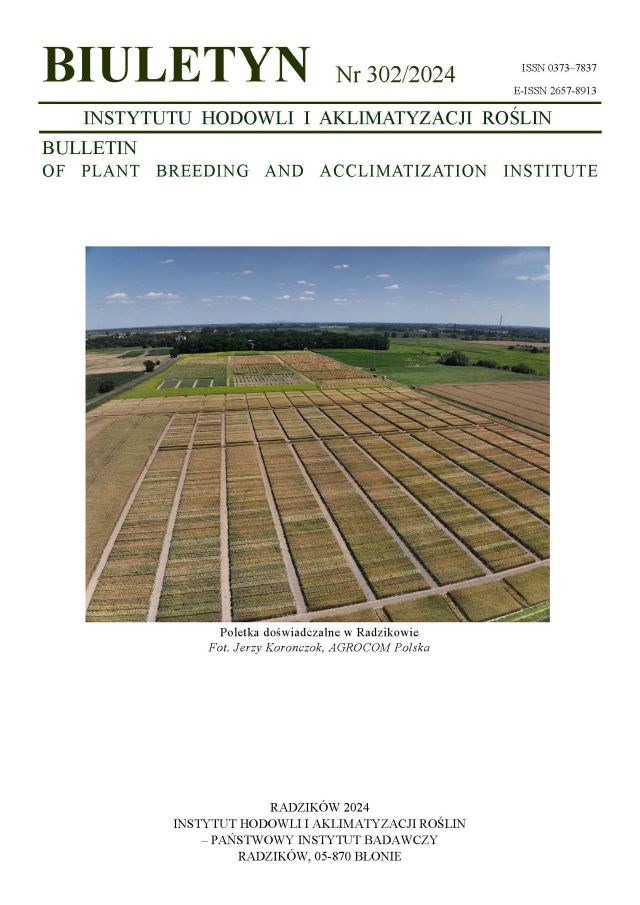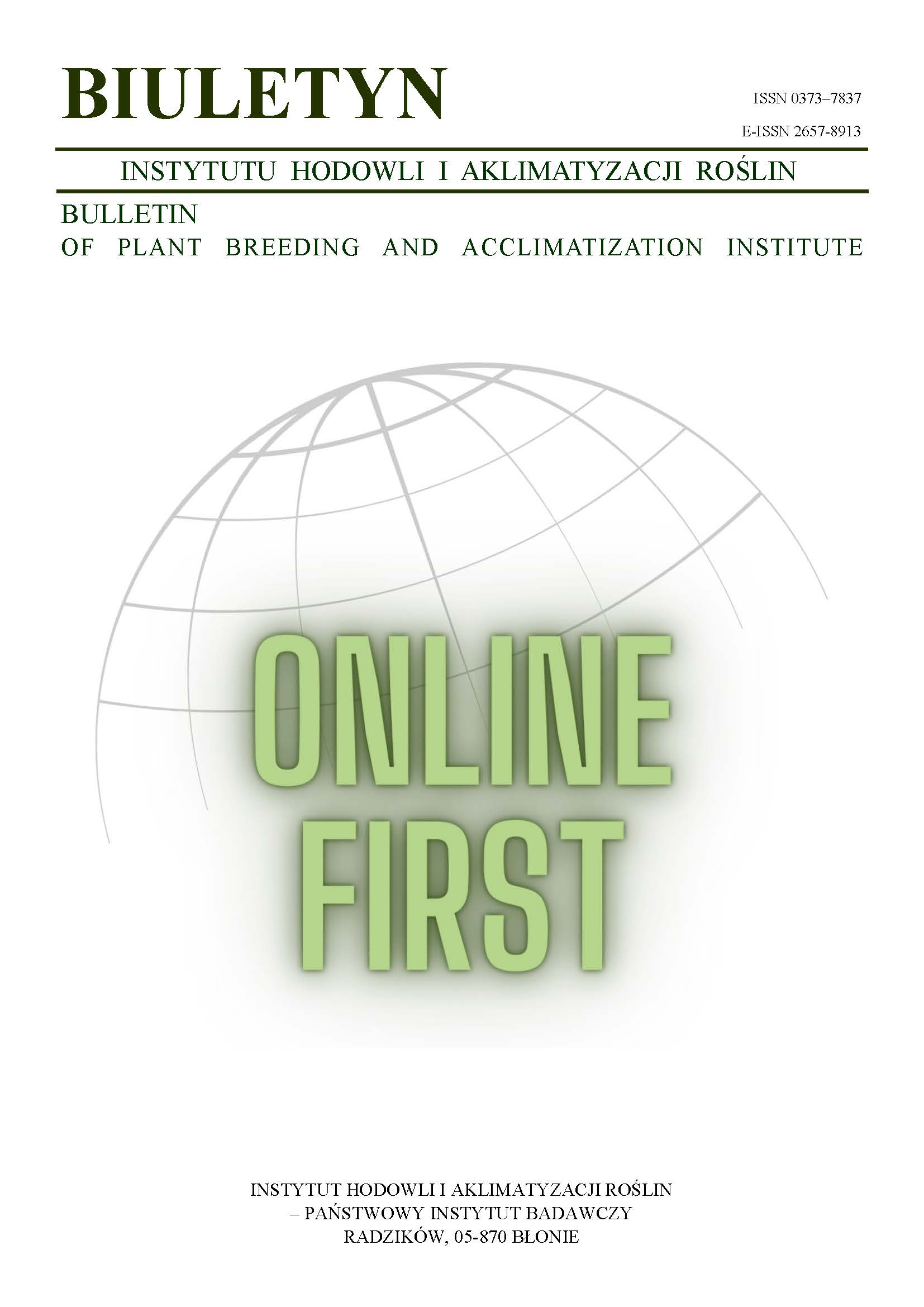Influence of sowing rate on Fidel stand and yielding of turfgrass cultivars of red fescue (Festuca rubra L.) grown for seed
Danuta Martyniak
d.martyniak@ihar.edu.plSamodzielna Pracownia Traw i Roślin Motylkowatych, Instytutu Hodowli i Aklimatyzacji Roślin w Radzikowie (Poland)
Abstract
Four cultivars representing two subspecies of red fescue were sown in a field experiment conducted in 2002–2004 in Radzików. Influence of sowing rate on real field stand, plant tillering and installation, as well as on seed yield was investigated. Theoretical sowing rate of 500 plants per 1 m2 (W2) in seed production, and even of 250 plants per 1 m2 (W3) in the case of stoloniferous forms, were found to be optimal. The sowing rate used so far, ranging from 770 to 1145 plants per 1 m2 (W1) depending on varietal differences in thousand seeds weight (TSW), appeared to be excessive. The real field stand was measured as field emergence index (PWW). Depending on sowing density, this index varied from 30% to 45% of the theoretical field stand established on the basis of germination capacity and varietal TSW. In general, seed yielding was affected most considerably by field stand in the year of sowing, determined by plant installation index (WIR). The higher seed yields in spite of the lower sowing rate and lower plant density were the effects of more intensive tillering (up to 30 shoots per plant) as well as of the increased TSW, ear length and ear weight.
Keywords:
Festuca rubra, field stand, generative shoots number, panicle, seed yield, sowing rate, tillering, thousand seeds weightReferences
Brown K. R., Lilli C. 1990. Cocksfoot. In: Management of grasses seed crops. Rowarth J. S. (ed.). Grassland Research and Practice Ser. No. New Zealand Grassld. Assoc. Palmerston North 56 — 57.
Google Scholar
Domański P., Martyniak J., Pojedyniec M. 1979. Zbiór instrukcji metodycznych prowadzenia doświadczeń odmianowych z trawami COBORU, Słupia Wielka: 22 — 33.
Google Scholar
Falkowski M., Kukułka I., Kozłowski S. 1996. Wykształcanie pędów generatywnych a plonowanie plantacji nasiennych traw. Biul. IHAR 199: 99 — 107.
Google Scholar
Hampton J. G., Fairey D. T. 1997. Components of seed yield in grasses and legumes. Forage Seed Production. Vol. 1: Temperate species. CAB International, Wallingford: 45 — 69.
Google Scholar
Hare M. D. 1993. Post-harvest and autumn of tall fescue seed yields. New Zealand J. Agric. Res. 36: 407 — 418.
DOI: https://doi.org/10.1080/00288233.1993.10417741
Google Scholar
Goliński P. 2000. Czynniki determinujące plonowanie plantacji nasiennych Festuca rubra L. Łąkarstwo w Polsce 3: 31 — 41.
Google Scholar
Kitczak T., Czyż H. 2001. Wpływ ilości wysiewu na plon nasion dwóch odmian kostrzewy czerwonej (Festuca rubra L.) i życicy trwałej (Lolium perenne L.) na glebie lekkiej. Zesz. Prob. PNR, 474: 293 — 299.
Google Scholar
Martyniak J., Żyłka D. 2001. Zależność obsady i instalacji roślin życicy trwałej od ilości wysiewu w uprawie na nasiona. Zeszyty Probl. PNR, 474: 283 — 297.
Google Scholar
Martyniak J., Martyniak D. 2002. Wpływ ilości wysianych nasion na obsadę roślin i plonowanie Lolium perenne w uprawie na nasiona. Łąkarstwo w Polsce 5: 145 — 154.
Google Scholar
Meijer W. J. M. 1984. Inflorescence production in plants and seed crops of Poa pratensis L. and Festuca rubra L. as affected by juvenility of tillers and tiller density. Netherl. J. Agr. Sci. 32: 119 — 136.
DOI: https://doi.org/10.18174/njas.v32i2.16911
Google Scholar
Prończuk S. 1993. System oceny traw gazonowych. Biul. IHAR 186: 127 — 132.
Google Scholar
Smith S. R. 1996. Pedigreed Forage Seed Production. Canadien Seed Growers Association, Ottawa: 53 pp.
Google Scholar
Żyłka D., Prończuk S., Prończuk M. 2001. Porównanie kępowych i rozłogowych podgatunków kostrzewy czerwonej (Festuca rubra L. ssp.) pod względem przydatności na użytkowanie trawnikowe i nasienne. Zesz. Probl. PNR 474: 103 — 112.
Google Scholar
Authors
Danuta Martyniakd.martyniak@ihar.edu.pl
Samodzielna Pracownia Traw i Roślin Motylkowatych, Instytutu Hodowli i Aklimatyzacji Roślin w Radzikowie Poland
Statistics
Abstract views: 19PDF downloads: 7
License
Copyright (c) 2005 Danuta Martyniak

This work is licensed under a Creative Commons Attribution-ShareAlike 4.0 International License.
Upon submitting the article, the Authors grant the Publisher a non-exclusive and free license to use the article for an indefinite period of time throughout the world in the following fields of use:
- Production and reproduction of copies of the article using a specific technique, including printing and digital technology.
- Placing on the market, lending or renting the original or copies of the article.
- Public performance, exhibition, display, reproduction, broadcasting and re-broadcasting, as well as making the article publicly available in such a way that everyone can access it at a place and time of their choice.
- Including the article in a collective work.
- Uploading an article in electronic form to electronic platforms or otherwise introducing an article in electronic form to the Internet or other network.
- Dissemination of the article in electronic form on the Internet or other network, in collective work as well as independently.
- Making the article available in an electronic version in such a way that everyone can access it at a place and time of their choice, in particular via the Internet.
Authors by sending a request for publication:
- They consent to the publication of the article in the journal,
- They agree to give the publication a DOI (Digital Object Identifier),
- They undertake to comply with the publishing house's code of ethics in accordance with the guidelines of the Committee on Publication Ethics (COPE), (http://ihar.edu.pl/biblioteka_i_wydawnictwa.php),
- They consent to the articles being made available in electronic form under the CC BY-SA 4.0 license, in open access,
- They agree to send article metadata to commercial and non-commercial journal indexing databases.
Most read articles by the same author(s)
- Danuta Martyniak, Barbara Wiewióra, Grzegorz Żurek, Influence of bio-waste from digestate of biogas plant on yielding and chemical composition of biomass of perennial grasses , Bulletin of Plant Breeding and Acclimatization Institute: No. 297/298 (2022): Regular issue
- Danuta Martyniak, Grzegorz Żurek, Cup plant (Silphium perfoliatum L.) prospects for use for biogas and feed , Bulletin of Plant Breeding and Acclimatization Institute: No. 297/298 (2022): Regular issue
- Grzegorz Żurek, Danuta Martyniak, Monika Żurek, Evaluation of the usefulness of straw from selected species and varieties of cereals and grasses for the production of drinking straws , Bulletin of Plant Breeding and Acclimatization Institute: No. 300 (2023): Regular issue
- Danuta Martyniak, Ewa Fabisiak, Waldemar Zielewicz, Józef Martyniak, The biological-chemical properties of tall wheat grass (Agropyron elongatum (Host., Beauv.) in terms of potential use as biomass for energy production , Bulletin of Plant Breeding and Acclimatization Institute: No. 260/261 (2011): Regular issue
- Elżbieta Małuszyńska, Anna Szydłowska, Danuta Martyniak, Szymon Dziamba, Joanna Dziamba, The influence of formulations containing effective microorganisms on germination capacity of organic seeds , Bulletin of Plant Breeding and Acclimatization Institute: No. 263 (2012): Regular issue
- Grzegorz Żurek , Danuta Martyniak , Kamil Prokopiuk , Agnieszka Rachwalska , Eugeniusz Paszkowski , Maciej Jurkowski , The examination of traits affecting seed formation as well as seed quality and yield in selected perennial grass species , Bulletin of Plant Breeding and Acclimatization Institute: No. 286 (2019): Special issue
- Danuta Martyniak, Dariusz Mańkowski, Variability of morphological and yield traits of new Polish breeding forms of common sorghum (Sorghum bicolor L.) , Bulletin of Plant Breeding and Acclimatization Institute: No. 302 (2024): Regular issue
- Dariusz Gozdowski, Danuta Martyniak, Izabela Lipska, Evaluation of selected traits diversity in turf grass cultivars of red fescue and Kentucky bluegrass , Bulletin of Plant Breeding and Acclimatization Institute: No. 274 (2014): Regular issue
- Dariusz Gozdowski, Danuta Martyniak, Wiesław Mądry, Multivariate evaluation of cultivars and advanced lines of perennial ryegrass in respect of traits important in seed production , Bulletin of Plant Breeding and Acclimatization Institute: No. 253 (2009): Regular issue
- Dariusz R. Mańkowski, Zbigniew Laudański, Danuta Martyniak, Małgorzata Flaszka, The structure of multivariable cultivar variation of Poa pratensis L. , Bulletin of Plant Breeding and Acclimatization Institute: No. 254 (2009): Regular issue














